Perfect Oven Roasted Salmon with Herb-Citrus Marinade
The Art of Perfectly Roasted Salmon
There’s something truly magical about a perfectly roasted salmon fillet. When done right, it’s a culinary masterpiece that balances delicate flavors with rich texture—flaky and tender on the inside with a beautifully caramelized exterior that simply melts in your mouth. This Oven Roasted Salmon recipe has become my signature dish, one that never fails to impress even the most discerning dinner guests and skeptical family members.
What makes this recipe truly special is its elegant simplicity paired with incredible flavor development. The vibrant herb-citrus marinade creates a perfect harmony of bright, tangy notes that complement the natural richness of the salmon without overpowering it. The high-temperature roasting method ensures that beautiful golden exterior while maintaining a moist, succulent interior that flakes perfectly with each forkful.
Over the years, this recipe has gained something of a legendary status in my household. It’s been the centerpiece of countless family gatherings, dinner parties, and special occasions. More importantly, it’s become the dish that has converted numerous “I don’t like fish” skeptics into passionate salmon enthusiasts. The combination of foolproof technique and vibrant flavors makes this a recipe worth mastering.
Understanding Salmon: A Chef’s Guide
Before diving into the recipe itself, let’s take a moment to understand the magnificent fish we’re working with. Salmon is truly one of nature’s culinary treasures—packed with heart-healthy omega-3 fatty acids, high-quality protein, and numerous vitamins and minerals. Beyond its nutritional profile, it offers a distinctive rich flavor and buttery texture that makes it stand out among seafood options.
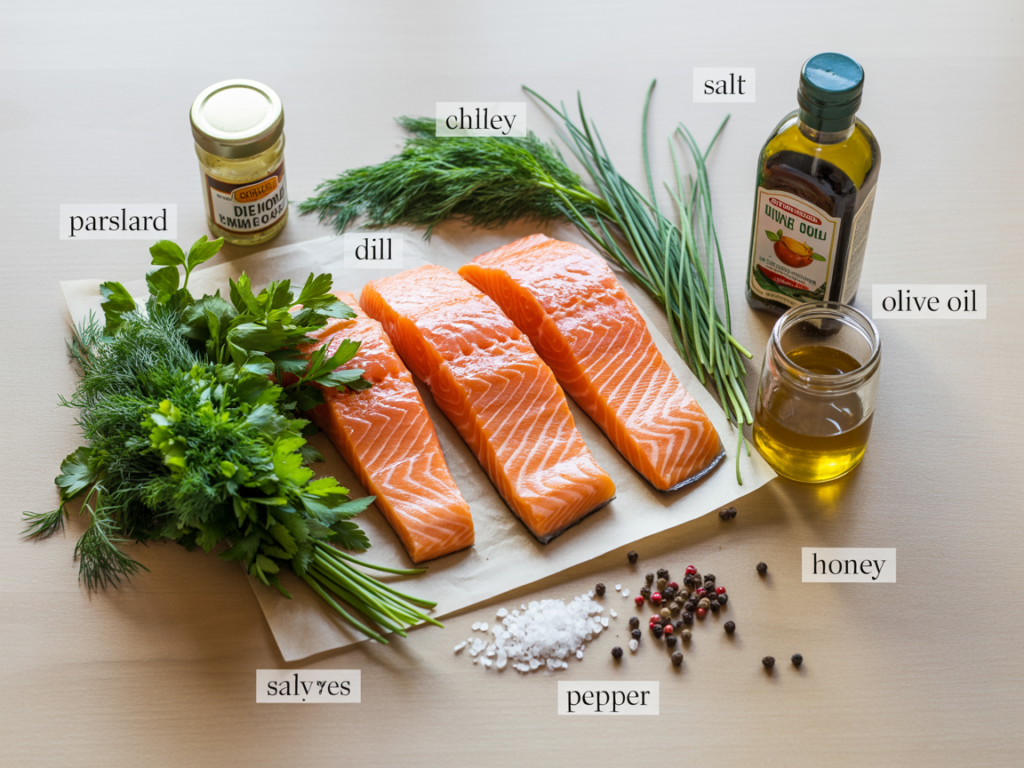
When shopping for salmon, you’ll encounter several varieties, each with its own unique characteristics:
- Atlantic Salmon: Often farm-raised, with a mild flavor and medium-firm texture
- King (Chinook) Salmon: Wild-caught, with the highest fat content and luxuriously rich flavor
- Sockeye Salmon: Known for its deep red color and pronounced flavor
- Coho (Silver) Salmon: Milder than sockeye with a delicate texture
- Pink Salmon: The most abundant variety, with a light color and subtle flavor
For this recipe, I recommend using either Atlantic or King salmon for their ideal fat content, which helps ensure a moist, flavorful result. Wild-caught salmon is generally preferred for its superior flavor and sustainability, but high-quality farm-raised salmon can also produce excellent results.
When selecting your fillets, look for:
- Vibrant, moist flesh with no discoloration
- A fresh, clean ocean scent (never fishy)
- Firm texture that springs back when pressed gently
- Clear, bright eyes and metallic skin if purchasing a whole fish
The Science of Perfect Salmon
Understanding the science behind cooking salmon elevates your culinary skills from good to exceptional. The key to perfect salmon lies in protein denaturation—the process where heat transforms the structure of proteins in the fish. This occurs between 120°F and 145°F (49-63°C).
At 125°F (52°C), salmon proteins begin to coagulate, creating that tender, flaky texture we love. By 140°F (60°C), the albumin (the white protein that sometimes appears on the surface) begins to be forced out. Past 145°F (63°C), moisture rapidly escapes, resulting in dry, overcooked fish.
This is precisely why we’ll be cooking our salmon at a high temperature (450°F/232°C) for a relatively short time. This approach allows the exterior to develop beautiful flavor through Maillard reaction (the browning process that creates complex flavors) while keeping the interior moist and tender. The marinade further protects the delicate flesh by creating a flavorful barrier that seals in moisture.
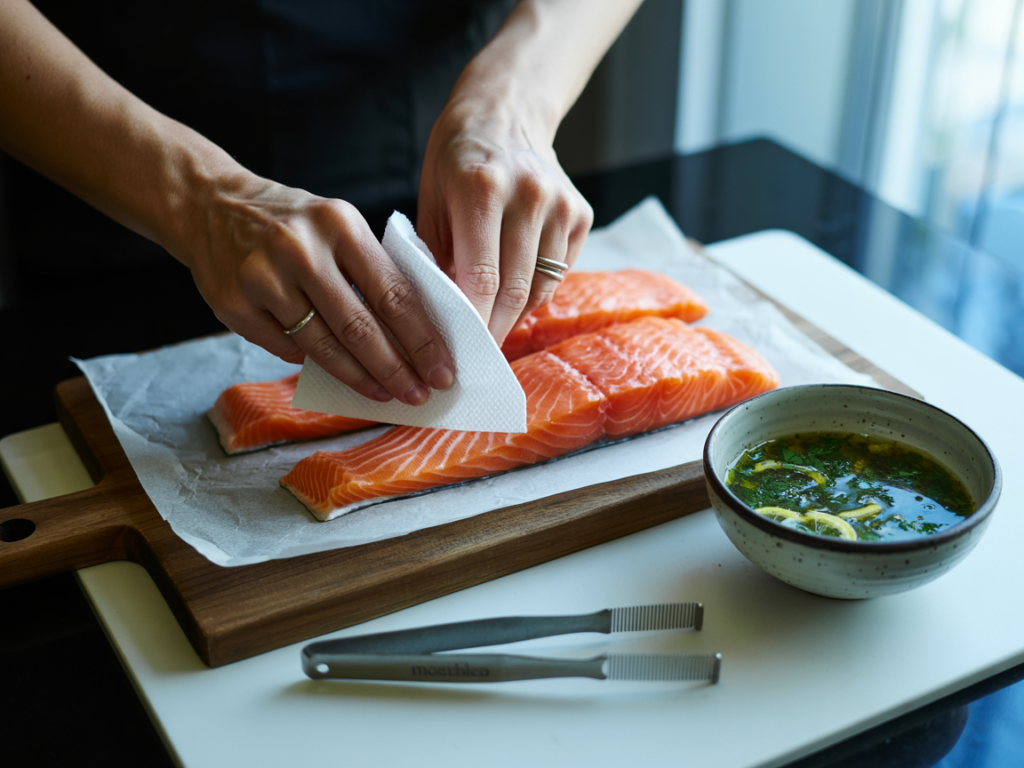
Key Ingredients for Flavor Perfection
The beauty of this recipe lies in its carefully balanced combination of high-quality ingredients that work together to enhance—never mask—the natural flavor of the salmon.
For the Star of the Show:
- Fresh Salmon Fillets (1½ pounds/680g): The foundation of our dish. Choose center-cut portions of even thickness for consistent cooking.
For the Vibrant Herb-Citrus Marinade:
- Fresh Herbs (3 tablespoons finely chopped): A blend of parsley, dill, and chives creates a garden-fresh aromatic base.
- Citrus Elements (2 tablespoons fresh lemon juice + zest of half a lemon): The bright acidity cuts through the richness of the salmon while adding a vibrant, fresh dimension.
- Garlic (3 cloves, minced): Provides a subtle pungency that becomes mellow and aromatic when roasted.
- Dijon Mustard (1 tablespoon): Adds tanginess and acts as an emulsifier for the marinade, helping it adhere to the salmon.
- Extra Virgin Olive Oil (2 tablespoons): Creates richness and helps conduct heat evenly across the surface of the fish.
- Honey (1 teaspoon): A touch of sweetness that balances the acidity and helps create beautiful caramelization.
- Sea Salt and Freshly Ground Black Pepper: Essential seasonings that enhance all other flavors.
For Serving:
- Lemon Slices: Not just for garnish—they continue infusing the salmon with bright flavor as it roasts.
- Additional Fresh Herbs: For a beautiful presentation and fresh flavor boost.
The Perfect Marriage: Salmon and Citrus
The pairing of salmon with citrus is one of the culinary world’s perfect marriages. This isn’t just about tradition or preference—there’s actual science behind why this combination works so brilliantly. The natural oils in salmon (especially those omega-3 fatty acids) can sometimes create a rich mouthfeel that borders on heaviness. The bright acidity of citrus cuts through this richness, creating a perfect balance on the palate.
Beyond flavor balance, citrus contains natural enzymes that gently break down proteins, creating a more tender texture when applied briefly before cooking. The aromatic oils in citrus zest also contain terpenes—volatile compounds that complement the natural flavors in the salmon and enhance our perception of freshness.
In our recipe, we’re utilizing both the juice and zest of fresh lemons. The juice provides that classic acidic brightness, while the zest contributes intense aromatic oils that infuse the salmon during the roasting process. The combination creates a multi-dimensional citrus experience that elevates the entire dish.
(ciąg dalszy w kolejnym poście – pełny, bez skrótów)
Kontynuacja pełnego tekstu bez znaków # – część 2:
Tools for Success
Setting yourself up for success begins with having the right tools on hand:
- Rimmed Baking Sheet: Essential for containing any juices that release during cooking
- Parchment Paper or Silicone Baking Mat: Creates a non-stick surface and makes cleanup a breeze
- Small Mixing Bowl: For preparing the marinade
- Whisk or Fork: To thoroughly blend the marinade ingredients
- Pastry Brush: For applying the marinade evenly across the salmon
- Kitchen Tweezers: Helpful for removing any pin bones from the fillets
- Instant-Read Thermometer: The most reliable way to ensure your salmon is perfectly cooked
Having these tools ready before you begin will streamline the cooking process and help ensure perfect results.
Step-by-Step Guide to Salmon Perfection
Preparation Phase
- Preheat your oven to 450°F (232°C).
- Prepare your baking surface by lining a rimmed baking sheet with parchment paper or a silicone baking mat.
- Inspect your salmon fillets for any remaining pin bones. Run your fingertips gently across the flesh. If found, remove them with kitchen tweezers.
- Pat the salmon dry with paper towels.
- Arrange the salmon fillets on your prepared baking sheet, skin-side down, leaving space between them.
Creating the Vibrant Marinade
- Combine the fresh herbs in a small bowl.
- Add the minced garlic, Dijon mustard, lemon zest, and honey.
- Whisk in the lemon juice and olive oil until emulsified.
- Season with sea salt and freshly ground black pepper.
Bringing It All Together
- Brush the marinade generously over each fillet.
- Place a lemon slice on top of each.
- Roast immediately to avoid acid “cooking” the fish like ceviche.
- Bake for 12–15 minutes at 450°F (232°C), depending on thickness.
- Check doneness with an instant-read thermometer: 135–140°F (57–60°C) for best results.
- Let rest for 2–3 minutes before serving.
Recognizing Perfectly Cooked Salmon
Perfect salmon flakes easily but stays moist inside. If you see white albumin, it’s getting well done—not bad, but less juicy. Ideally, you want a glistening interior and caramelized exterior.
Serving Suggestions
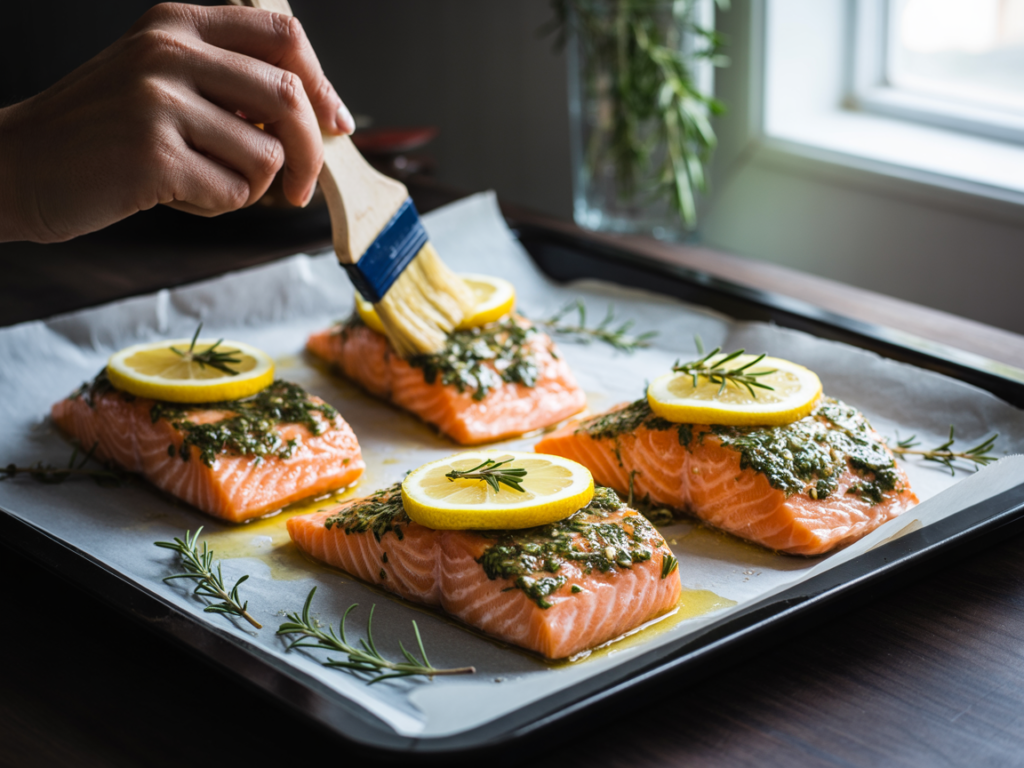
Grain-Based Accompaniments:
- Lemon-herb quinoa with toasted pine nuts
- Wild rice pilaf with dried cranberries and herbs
- Pearl couscous with roasted vegetables and fresh mint
- Farro salad with cucumber, tomato, and feta
Vegetable Pairings:
- Roasted asparagus with garlic and parmesan
- Sautéed green beans with caramelized shallots
- Honey-glazed carrots with fresh thyme
- Roasted Brussels sprouts with balsamic reduction
- Simple arugula salad with lemon vinaigrette
Sauce Options (for serving):
- Creamy dill and caper sauce
- Lemon-herb yogurt sauce
- Light cucumber-dill tzatziki
- Warm cherry tomato vinaigrette
Wine Pairing Recommendations
- Chardonnay: A lightly oaked version offers buttery notes that complement the richness of the salmon while maintaining enough acidity to balance the dish.
- Pinot Noir: A light-bodied red that won’t overpower the salmon, with earthy undertones that play well with the herb elements.
- Sauvignon Blanc: Its bright citrus notes mirror and enhance the lemon in the marinade.
- Rosé: A dry rosé provides refreshing acidity while standing up to the salmon’s richness.
- Sparkling Wine: The effervescence cuts through the richness of the salmon, while the crisp acidity complements the citrus elements.
Storage and Repurposing: Extending the Experience
While this salmon is undoubtedly best enjoyed fresh from the oven, proper storage can maintain quality for later enjoyment:
Storage Guidelines:
- Refrigeration: Cool completely before storing in an airtight container for up to 3 days.
- Freezing: While not ideal, you can freeze cooked salmon. Wrap individual portions tightly in plastic wrap, then place in freezer bags with air removed. Use within 2 months.
- Reheating: Gentle reheating is crucial. Cover and warm in a 275°F (135°C) oven until just heated through, about 15 minutes. Alternatively, bring to room temperature and enjoy cold or at room temperature.
Creative Repurposing Ideas:
- Salmon Salad: Flake leftover salmon over mixed greens with cucumber, avocado, and a light vinaigrette.
- Salmon Cakes: Combine flaked salmon with panko breadcrumbs, egg, herbs, and a touch of mayonnaise. Form into patties and pan-fry until golden.
- Salmon Pasta: Toss flaked salmon with pasta, cream sauce, peas, and fresh dill for a quick weeknight dinner.
- Salmon Breakfast Hash: Incorporate into a breakfast hash with potatoes, bell peppers, onions, and a poached egg on top.
Frequently Asked Questions
Q: Can I use frozen salmon for this recipe?
A: Yes, but thaw it completely in the refrigerator overnight and pat thoroughly dry before proceeding with the recipe.
Q: How do I remove the skin from salmon?
A: While you can ask your fishmonger to remove it, I recommend cooking the salmon with the skin on as it helps hold the delicate flesh together during cooking. Diners can easily separate the flesh from the skin while eating. If you must remove it, place the fillet skin-side down on a cutting board, grip the skin at one end with a paper towel, and use a sharp knife to separate the flesh from the skin with a horizontal sawing motion.
Q: Can I prepare the marinade in advance?
A: Yes, the marinade can be prepared up to 24 hours in advance and stored in an airtight container in the refrigerator. However, only apply it to the salmon right before cooking to prevent the acid from beginning to “cook” the fish.
Q: What’s the best way to serve salmon for a dinner party?
A: For an impressive presentation, consider roasting a whole side of salmon and bringing it to the table on a wooden serving board garnished with fresh herbs, lemon slices, and edible flowers. The family-style service creates a wonderful communal dining experience.
Q: How can I tell if my salmon has gone bad?
A: Fresh salmon should have a mild ocean scent (never fishy), firm and resilient flesh, and bright color. If the salmon has a strong ammonia-like odor, slimy texture, or dull, discolored appearance, it should be discarded.
Healthful Benefits: Nourishment Beyond Flavor
Beyond its exceptional flavor, this Oven Roasted Salmon offers impressive nutritional benefits:
- Omega-3 Fatty Acids: These essential fats support heart and brain health, reduce inflammation, and may help lower risk factors for chronic diseases.
- High-Quality Protein: Salmon provides all essential amino acids, supporting muscle maintenance and repair.
- Vitamin D: Often called the “sunshine vitamin,” it’s crucial for bone health and immune function.
- B Vitamins: Particularly B12, which supports red blood cell formation and neurological function.
- Selenium: An important antioxidant that helps protect cells from damage.
- Potassium: Essential for maintaining healthy blood pressure and proper fluid balance.
The minimally processed, whole-food approach of this recipe preserves these natural nutrients while adding the antioxidant benefits of fresh herbs and citrus. It’s truly a dish that nourishes both body and soul.
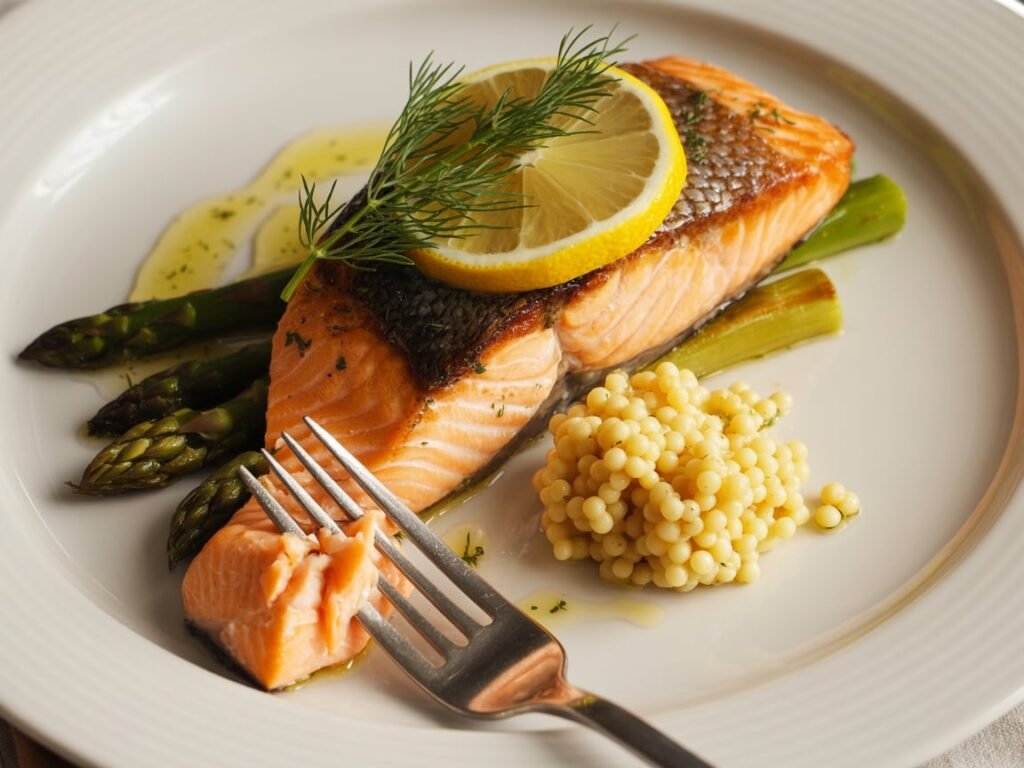
A Final Note: The Joy of Cooking
Cooking is more than following instructions—it’s about creating experiences and memories. This Oven Roasted Salmon recipe offers an opportunity to connect with the timeless tradition of transforming simple ingredients into something magnificent. As you master this technique, you’ll gain confidence in working with seafood and develop an intuitive understanding of flavors and cooking methods that will serve you well beyond this single recipe.
I encourage you to make this recipe your own. Perhaps you’ll add a touch of grated ginger for warmth, incorporate different herbs based on seasonal availability, or experiment with orange instead of lemon for a sweeter citrus note. The fundamental technique will support endless variations as you develop your personal culinary signature.
Whether you’re preparing this salmon for a quiet family dinner or an elegant gathering of friends, the simplicity of preparation combined with the impressive results makes this a recipe worth returning to time and again. Enjoy the process, savor the results, and share the joy of good food with those around your table.

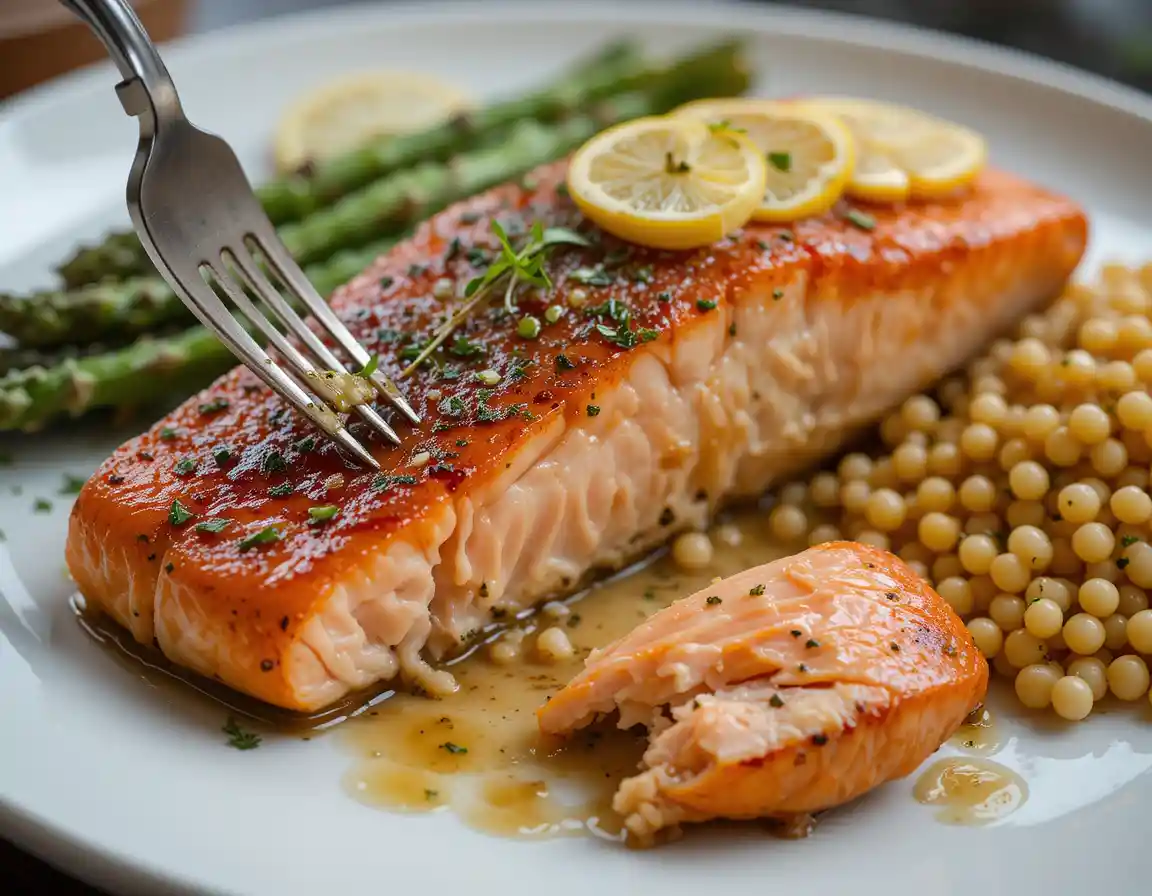



Interesting read on oven-roasted salmon. But does anyone else think that adding a bit of smoked paprika could elevate the flavors? Would love to hear your thoughts!
Does anyone think adding a bit of smoked paprika to the oven-roasted salmon will give it a nice kick, or would it overpower the delicate salmon flavor? Its a curious experiment, isnt it?
Does anyone else think its weird that the article didnt mention what temperature to set the oven at for this roasted salmon? Seems like a pretty important detail to skip over.
Interesting article! Just curious, wouldnt grilling the salmon over a cedar plank introduce more flavor than oven roasting? Plus, it adds a fun BBQ element. Thoughts anyone?
Just throwing this out there, but dont you think oven roasting actually overcooks the salmon? Wouldnt grilling or pan-searing offer more control over the cooking process, ensuring a juicier result?
Just a thought, but could we consider broiling the salmon instead of oven roasting? Ive found it gives a nice, crispy texture! Anybody else tried this, or am I just causing kitchen chaos here?
While I appreciate the simplicity of oven-roasted salmon, dont you think incorporating unconventional flavor pairings like dark chocolate or chili could elevate the dish? It might just reinvent our perception of seafood.
Why not try roasting salmon skin side up sometimes? It gets so crispy and adds an interesting texture to the dish.
Interesting read, but did anyone else wonder if marinating the salmon first could enhance the flavor even more? Just a thought.
Interesting read! But has anyone ever tried roasting salmon with a dash of cinnamon? Might add a unique twist. Thoughts?
Why not broil instead of oven roast? Could add a tasty char to the salmon, might amp up the flavor game!
Roasting salmon in oven, isnt it essentially baking? Or is there a difference?
Ever tried using cedar planks for roasting salmon? Major flavor game-changer!
Ever tried roasting salmon on cedar planks? Enhances flavor tenfold!
Why not try roasting salmon with a bit of honey and garlic?